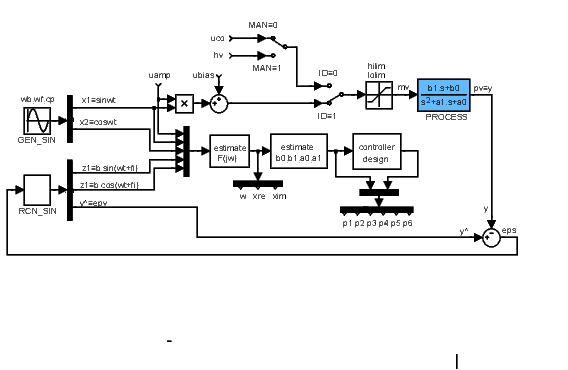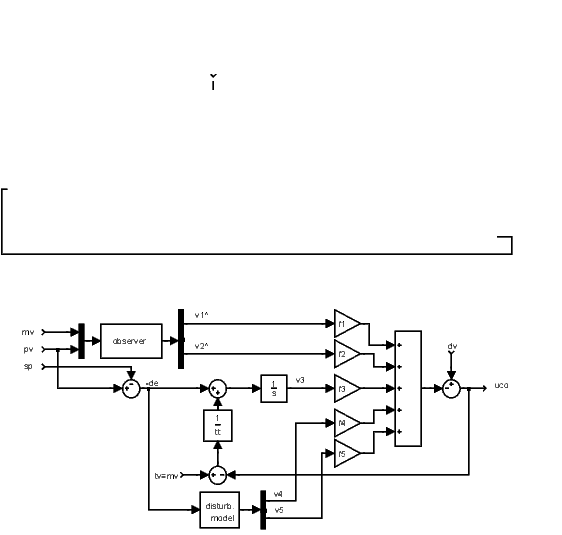SC2FA – State controller for 2nd order system with frequency autotuner
Block SymbolLicensing group: AUTOTUNING

Function Description
The SC2FA block implements a state controller for 2nd order system (7.4) with frequency
autotuner. It is well suited especially for control (active damping) of lightly damped systems
(ξ<0.1). But
it can be used as an autotuning controller for arbitrary system which can be described with
sufficient precision by the transfer function
| F(s)=b1s+b0s2+2ξΩs+Ω2, | (7.4) |
where Ω>0 is the natural (undamped) frequency, ξ, 0<ξ<1, is the damping coefficient and b1, b0 are arbitrary real numbers. The block has two operating modes: "Identification and design mode" and "Controller mode".
The "Identification and design mode" is activated by the binary input ID=on. Two points of frequency response with given phase delay are measured during the identification experiment. Based on these two points a model of the controlled system is built. The experiment itself is initiated by the rising edge of the RUN input. A harmonic signal with amplitude uamp, frequency ω and bias ubias then appears at the output mv. The frequency runs through the interval ⟨wb,wf⟩, it increases gradually. The current frequency is copied to the output w. The rate at which the frequency changes (sweeping) is determined by the cp parameter, which defines the relative shrinking of the initial period Tb=2πwb of the exciting sine wave in time Tb, thus
The cp parameter usually lies within the interval
cp∈⟨0,95;1). The lower the
damping coefficient ξ
of the controlled system is, the closer to one the cp parameter must be.
At the beginning of the identification period the exciting signal has a frequency of ω=wb. After a period of stime seconds the estimation of current frequency response point starts. Its real and imaginary parts are available at the xre and xim outputs. If the MANF parameter is set to 0, then the frequency sweeping is stopped two times during the identification period. This happens when points with phase delay of ph1 and ph2 are reached for the first time. The breaks are stime seconds long. Default phase delay values are −60∘ and −120∘, respectively, but these can be changed to arbitrary values within the interval (−360∘,0∘), where ph1>ph2. At the end of each break an arithmetic average is computed from the last iavg frequency point estimates. Thus we get two points of frequency response which are successively used to compute the controlled process model in the form of (7.4). If the MANF parameter is set to 1, then the selection of two frequency response points is manual. To select the frequency, set the input HLD=on, which stops the frequency sweeping. The identification experiment continues after returning the input HLD to 0. The remaining functionality is unchanged.
It is possible to terminate the identification experiment prematurely in case of necessity by the input BRK=on. If the two points of frequency response are already identified at that moment, the controller parameters are designed in a standard way. Otherwise the controller design cannot be performed and the identification error is indicated by the output signal IDE=on.
The IDBSY output is set to 1 during the "identification and design" phase. It is set back to 0 after the identification experiment finishes. A successful controller design is indicated by the output IDE=off. During the identification experiment the output iIDE displays the individual phases of the identification: iIDE=−1 means approaching the first point, iIDE=1 means the break at the first point, iIDE=−2 means approaching the second point, iIDE=2 means the break at the second point and iIDE=−3 means the last phase after leaving the second frequency response point. An error during the identification phase is indicated by the output IDE=on and the output iIDE provides more information about the error.
The computed state controller parameters are taken over by the control algorithm as soon as the SETC input is set to 1 (i.e. immediately if SETC is constantly set to on). The identified model and controller parameters can be obtained from the p1, p2, …, p6 outputs after setting the ips input to the appropriate value. After a successful identification it is possible to generate the frequency response of the controlled system model, which is initiated by a rising edge at the MFR input. The frequency response can be read from the w, xre and xim outputs, which allows easy confrontation of the model and the measured data.
The "Controller mode" (binary input ID=off) has manual (MAN=on) and automatic (MAN=off) submodes. After a cold start of the block with the input ID=off it is assumed that the block parameters mb0, mb1, ma0 and ma1 reflect formerly identified coefficients b0, b1, a0 and a1 of the controlled system transfer function and the state controller design is performed automatically. Moreover if the controller is in the automatic mode and SETC=on, then the control law uses the parameters from the very beginning. In this way the identification phase can be skipped when starting the block repeatedly.

The diagram above is a simplified inner structure of the frequency autotuning part of the controller. The diagram below shows the state feedback, observer and integrator anti-wind-up. The diagram does not show the fact, that the controller design block automatically adjusts the observer and state feedback parameters f1,…,f5 after identification experiment (and SETC=on).

The controlled system is assumed in the form of (7.4). Another forms of this transfer function are
| F(s)=(b1s+b0)s2+a1s+a0 | (7.5) |
and
| F(s)=K0Ω2(τs+1)s2+2ξΩs+Ω2. | (7.6) |
The coefficients of these transfer functions can be found at the outputs p1,...,p6 after the identification experiment (IDBSY=off). The output signals meaning is switched when a change occurs at the ips input.
Inputs
dv | Feedforward control variable | Double (F64) |
sp | Setpoint variable | Double (F64) |
pv | Process variable | Double (F64) |
tv | Tracking variable | Double (F64) |
hv | Manual value | Double (F64) |
MAN | Manual or automatic mode | Bool |
|
|
|
ID | Identification or controller operating mode | Bool |
|
|
|
TUNE | Start the tuning experiment (off→on), the exciting harmonic signal is generated | Bool |
HLD | Stop frequency sweeping | Bool |
BRK | Termination signal | Bool |
SETC | Flag for accepting the new controller parameters and updating the control law | Bool |
|
|
|
ips | Switch for changing the meaning of the output signals | Long (I32) |
|
|
|
MFR | Generation of the parametric model frequency response at the w, xre and xim outputs (off→on triggers the generator) | Bool |
Outputs
mv | Manipulated variable (controller output) | Double (F64) |
de | Deviation error | Double (F64) |
SAT | Saturation flag | Bool |
|
|
|
IDBSY | Identification running | Bool |
|
|
|
w | Frequency response point estimate - frequency in rad/s | Double (F64) |
xre | Frequency response point estimate - real part | Double (F64) |
xim | Frequency response point estimate - imaginary part | Double (F64) |
epv | Reconstructed pv signal | Double (F64) |
IDE | Identification error indicator | Bool |
|
|
|
iIDE | Error code | Long (I32) |
|
|
|
p1..p6 | Results of identification and design phase | Double (F64) |
Parameters
ubias | Static component of the exciting harmonic signal | Double (F64) |
uamp | Amplitude of the exciting harmonic signal ⊙1.0 | Double (F64) |
wb | Frequency interval lower limit [rad/s] ⊙1.0 | Double (F64) |
wf | Frequency interval upper limit [rad/s] ⊙10.0 | Double (F64) |
isweep | Frequency sweeping mode ⊙1 | Long (I32) |
|
|
|
cp | Sweeping rate ↓0.5 ↑1.0 ⊙0.995 | Double (F64) |
iavg | Number of values for averaging ⊙10 | Long (I32) |
alpha | Relative positioning of the observer poles (in identification phase) ⊙2.0 | Double (F64) |
xi | Observer damping coefficient (in identification phase) ⊙0.707 | Double (F64) |
MANF | Manual frequency response points selection | Bool |
|
|
|
ph1 | Phase delay of the 1st point in degrees ⊙-60.0 | Double (F64) |
ph2 | Phase delay of the 2nd point in degrees ⊙-120.0 | Double (F64) |
stime | Settling period [s] ⊙10.0 | Double (F64) |
ralpha | Relative positioning of the observer poles ⊙4.0 | Double (F64) |
rxi | Observer damping coefficient ⊙0.707 | Double (F64) |
acl1 | Relative positioning of the 1st closed-loop poles couple ⊙1.0 | Double (F64) |
xicl1 | Damping of the 1st closed-loop poles couple ⊙0.707 | Double (F64) |
INTGF | Integrator flag ⊙on | Bool |
|
|
|
apcl | Relative position of the real pole ⊙1.0 | Double (F64) |
DISF | Disturbance flag | Bool |
|
|
|
dom | Disturbance model natural frequency ⊙1.0 | Double (F64) |
dxi | Disturbance model damping coefficient | Double (F64) |
acl2 | Relative positioning of the 2nd closed-loop poles couple ⊙2.0 | Double (F64) |
xicl2 | Damping of the 2nd closed-loop poles couple ⊙0.707 | Double (F64) |
tt | Tracking time constant ⊙1.0 | Double (F64) |
hilim | Upper limit of the controller output ⊙1.0 | Double (F64) |
lolim | Lower limit of the controller output ⊙-1.0 | Double (F64) |
mb1p | Controlled system transfer function coefficient b1 | Double (F64) |
mb0p | Controlled system transfer function coefficient b0 ⊙1.0 | Double (F64) |
ma1p | Controlled system transfer function coefficient a1 ⊙0.2 | Double (F64) |
ma0p | Controlled system transfer function coefficient a0 ⊙1.0 | Double (F64) |
[Previous] [Back to top] [Up] [Next]
2023 © REX Controls s.r.o., www.rexygen.com